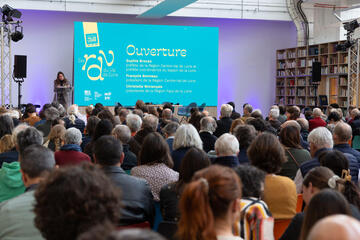The Loire châteaux are an essential feature of the Loire Valley World Heritage site’s cultural landscape. The site’s monuments also play their part in its daily life, through the restorations and developments carried out and the new facilities created. A close-up look at what’s going on at Azay-le-Rideau, Amboise, Chinon and Fontevraud Abbey.
Azay-le-Rideau: renaissance of a bedroom
As no château in France could lay claim to harbouring the original decor of a 16th-century bedroom – an era in which walls and floors were often covered with rush matting – the Centre for National Monuments decided to recreate such original decoration at Château d'Azay-le-Rideau. A scientific committee was set up to ensure respect for historical accuracy with regard to 16th-century know-how and materials, and Felicity Irons from Rushmatters in Bedfordshire, the only company in Europe to have preserved the required know-how, carried out the restoration.
Since early December, visitors have been able to get the feel of a real Renaissance bedroom.
Major restoration work is also on the programme, including restoration of the Romantic Park, which is listed as a Historical Monument.
On the web:
Chinon: Heritage at your fingertips
As part of an accessibility project underway at the Royal Fortress of Chinon, tactile discovery tools have been installed in the Royal Lodge and at the foot of the Coudray Tower, including a tactile miniature reproduction of the “Recognition scene” tapestry and a set of 5 tactile models explaining the fortress’s architectural development in the Middle Ages as well as its present state.
Programming of visits specially adapted to the visually impaired is planned for 2013; adapted visits can also be organised upon request.
On the web:
Amboise: restoration of the ramparts
An initial phase of restoration work on the ramparts is almost complete. Over 2 million euros have been devoted to the project between 2001 and 2012, 31% paid out by the Saint-Louis Foundation, which owns the château, and 39% by the State.
Apart from work necessitated by natural erosion; the project provides an opportunity to put the spotlight on a number of features that help visitors understand the monument better, including the window casements of a building that disappeared several centuries ago.
On the web:
Initial observations on the part of Maine-et-Loire’s Départemental Archaeology Service during restoration work on the south façade of Château d’Angers led the Centre for National Monuments to order dendrochronological analysis of wood from the portcullis still in place at the Porte des Champs gateway. It appears that it is the oldest portcullis in France, dating from between 1370 and 1384.
Fontevraud: the Treasure room
With a view to helping its many visitors improve their knowledge of its history, Fontevraud Abbey is in the process of setting up a seven-stage museographic itinerary covering its monastic period as well as its use as a prison. The project, which has been underway since 2009, is scheduled for completion in 2014.
The itinerary’s central area was inaugurated on 29 November. Entitled “Treasure Room”, it is without doubt the project’s nodal point, exhibiting a collection of precious artefacts that bear witness to the monument’s history, from Romanesque capitals to a pack of cards kept in secret by one of the Abbey’s prisoners – testifying also to the stories of the many nameless men and women who spent time within its walls.




![Nouvelles Renaissance(s] 2023](/var/storage/images/val-de-loire-refonte/dossier-de-parametrage/pied-de-page/nouvelles-renaissance-s-2023/517479-13-fre-FR/Nouvelles-Renaissance-s-2023_image_largeur220.png)


 Lettre d'information
Lettre d'information
 Facebook
Facebook
 Flickr
Flickr
 Podcloud
Podcloud
 Dailymotion
Dailymotion
 Box
Box
 Slideshare
Slideshare
 Diigo
Diigo

